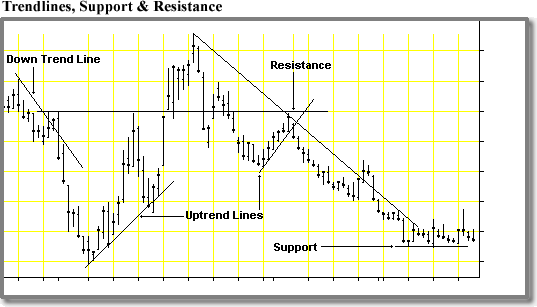|
There are two components to trend, direction and duration. Markets trend in three directions, up, down and sideways. Markets do not move consistently in one direction, but tend to be erratic. Within this erratic behaviour a trend will be present. Trends are characterized by a series of peaks and troughs. An uptrend is a series of rising peaks and troughs, a downtrend shows a series of descending peaks and troughs. A sideways tend is a series of horizontal peaks and troughs, with prices moving within a range, failing to make new highs at the top of the price range and failing to make new lows at the bottom of the price range.
Trend duration is also made up of three time periods; major, intermediate and minor. The major trend will have a duration of six to eight months or longer and is best illustrated by weekly and monthly bar charts. Within the major trend significant corrections or reversals of trend will be present; these would be intermediate and minor trends within the major trend. The intermediate trend lasts from three weeks to three months, and the minor trend is anything less, from two to three weeks in duration.
Support and resistance are tools used by technicians to help them identify and follow price trends. Horizontal lines are drawn on the bar chart to indicate areas of support and resistance. The troughs or reaction lows on a price chart are identified as support. Support is an area on the chart where buying pressure overtakes selling pressure and the market reacts higher. Usually support is identified by a previous reaction low or trough on the bar chart. Resistance is an area on the chart where selling pressure overtakes buying pressure and the market reacts lower. A resistance level is identified by a previous price high or peak on the bar chart.
The concepts of support and resistance are critically important tools used by technicians to help them identify and follow trends. Lines are drawn on the chart to indicate areas of price support, price resistance and price trends. In an uptrend, the resistance levels represent pauses in the uptrend which serve to temporarily halt the price advance. In like manner, in a downtrend, support levels will temporarily halt a price decline. Trend lines are drawn above or below the market action depending upon the direction of the move. During an uptrend a line would be drawn from the first significant low to the next, extending across the page from left to right. (see example 5) If the uptrend is valid you will find the price will move to, or close to, the uptrend line on corrections and then move higher. Each time a trend line is tested and holds, the more significant it becomes. Each time a previous support or resistance level is being tested the prevailing trend of the market is critically analyzed by the technician. Failure to exceed a previous resistance peak in an uptrend, or to break a previous support low in a downtrend, provides a warning that the existing trend may be changing. The testing of these support and resistance levels form pictures on the charts that suggest either a trend reversal or simply a pause in the prevailing trend. The basic building blocks on which price patterns are based however, are support and resistance.

Support and resistance levels reverse roles once they are decisively broken . In other words if the price penetrates a resistance level, then it will generally move upward to the next resistance level, such that the previous resistance level will now become an area of support. The longer the period of time that prices trade in a support or resistance area, the more significant that area becomes. For example, if prices trade sideways for three weeks in a support area before moving higher, that support area would be more significant than if only three days of trading had occurred. The reason for this is that there are now more participants in the market with a vested interest in that support area which will hold prices up.
[ PREVIOUS: Bar Charts ] -- [ CONTENTS ] --
[ NEXT: Volume & Open Interest ]
|